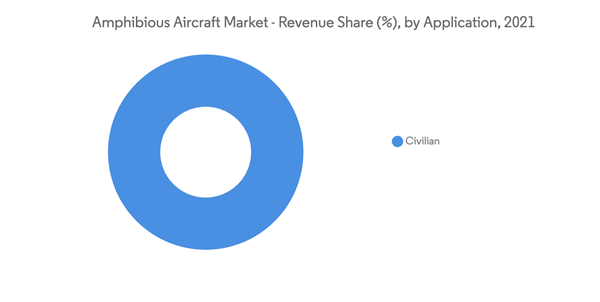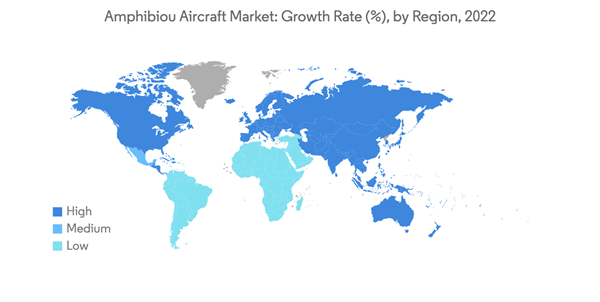The amphibious aircraft market is projected to grow to USD XX Million at a CAGR of XX% during the forecast period (2022 - 2027).
The COVID-19 pandemic significantly affected the amphibious aircraft market. Despite the significant investments from militaries into new aircraft and military weaponry have had just a little positive effect on the market. Due to the global transportation halt because of the lockdown and social distancing norms, the need and demand for civilian aircraft significantly reduced the opportunities for the market during the pandemic.
However, the increasing travel and tourism post the pandemic has propelled the market toward steady growth expected to transcend into the forecast period.
Currently, the market is witnessing various innovations to increase the speed of amphibious aircraft. Using sea foils for amphibious aircraft is the current innovation by companies (like LISA Airplanes done on their Akoya Amphibious Aircraft model). The sea foils are fitted to the aircraft's fuselage and are used to lift the aircraft's fuselage at high speeds while taking off from the water. This innovation has eliminated the need to design amphibious aircraft with a traditional hull shape.
Globally, various naval forces, such as the United States and Japan, are placing orders for amphibious aircraft to carry out various strategic missions. Thus, various upcoming developments, in terms of amphibious aircraft for the military, are expected to increase the focus on this segment, and this may be the reason for its expected high growth rate. India has also been in contact with Japan since February 2020 for a partnership to develop the US-2i amphibious aircraft to serve the naval officials with plans to purchase 12 SinMaywa US-2i Amphibious and Rescue (SAR) aircraft for USD 1.65 Billion. Due to such developments, the military segment of the market is expected to witness a significant growth rate during the forecast period.
Furthermore, international partnerships within the region are expected to drive the demand for amphibious aircraft. Delta Aerospace has been keen on developing amphibious aircraft to cater to the projected demand during the forecast period. In June 2022, the company announced the establishment of a training and maintenance hub for amphibious aircraft for the LA-8 aircraft by Delta in Malaysia. The company also signed an MoU with Linggi Marine and Ship Services Bhd to build an integrated seaplane manufacturing site in the Linggi region of the country. India has also been trying to improve the amphibious aircraft services in the country. For instance, in June 2021, a Memorandum of Understanding (MoU) was signed by the Civil Aviation Ministry of India and the Waterways Ministry of India to increase seaplane services in the country. A total of 28 routes were awarded for this purpose under a scheme named UDAN, and it was announced by the ministries that the required water aerodromes would be constructed by 2024.
This product will be delivered within 2 business days.
The COVID-19 pandemic significantly affected the amphibious aircraft market. Despite the significant investments from militaries into new aircraft and military weaponry have had just a little positive effect on the market. Due to the global transportation halt because of the lockdown and social distancing norms, the need and demand for civilian aircraft significantly reduced the opportunities for the market during the pandemic.
However, the increasing travel and tourism post the pandemic has propelled the market toward steady growth expected to transcend into the forecast period.
Currently, the market is witnessing various innovations to increase the speed of amphibious aircraft. Using sea foils for amphibious aircraft is the current innovation by companies (like LISA Airplanes done on their Akoya Amphibious Aircraft model). The sea foils are fitted to the aircraft's fuselage and are used to lift the aircraft's fuselage at high speeds while taking off from the water. This innovation has eliminated the need to design amphibious aircraft with a traditional hull shape.
Key Market Trends
Military Segment of the Market is Expected to Witness Decent Growth Rate During the Forecast Period
Currently, the military segment has the highest share out of all the segments. Globally, there has been an increasing demand for amphibious aircraft from the naval forces. Naval forces are placing orders for amphibious aircraft to conduct various operations, such as search and rescue, surveillance, and reconnaissance missions. China also announced they could use the AG600 amphibious aircraft to ferry their troops and equipment to the South China Sea. In February 2022, China was observed testing the latest amphibious aircraft, AG600, for military and maritime coverage of the entire South China sea. The aircraft, developed for firefighting and water rescue, is also used for military uses because the aircraft can seat up to 50 passengers. This led the Chinese government to consider the aircraft the appropriate choice for troop transportation.Globally, various naval forces, such as the United States and Japan, are placing orders for amphibious aircraft to carry out various strategic missions. Thus, various upcoming developments, in terms of amphibious aircraft for the military, are expected to increase the focus on this segment, and this may be the reason for its expected high growth rate. India has also been in contact with Japan since February 2020 for a partnership to develop the US-2i amphibious aircraft to serve the naval officials with plans to purchase 12 SinMaywa US-2i Amphibious and Rescue (SAR) aircraft for USD 1.65 Billion. Due to such developments, the military segment of the market is expected to witness a significant growth rate during the forecast period.
The Asia-Pacific Region is Expected to Witness Significant Growth Rate During the Forecast Period
The amphibious aircraft market has been gaining significant traction in the Asia-Pacific region. Manufacturers of current-production utility aircraft see many market opportunities for their aircraft in the Asia-Pacific region, performing various civilian, government, and military missions. International aircraft manufacturers are looking to invest in manufacturing unpressurized and amphibious aircraft as a result of expected growth in demand during the forecast period. For instance, Textron Aviation sees the Asia-Pacific market for the new Cessna 408 SkyCourier with a high potential for the aircraft to find uses in amphibious scenarios for civilian purposes.Furthermore, international partnerships within the region are expected to drive the demand for amphibious aircraft. Delta Aerospace has been keen on developing amphibious aircraft to cater to the projected demand during the forecast period. In June 2022, the company announced the establishment of a training and maintenance hub for amphibious aircraft for the LA-8 aircraft by Delta in Malaysia. The company also signed an MoU with Linggi Marine and Ship Services Bhd to build an integrated seaplane manufacturing site in the Linggi region of the country. India has also been trying to improve the amphibious aircraft services in the country. For instance, in June 2021, a Memorandum of Understanding (MoU) was signed by the Civil Aviation Ministry of India and the Waterways Ministry of India to increase seaplane services in the country. A total of 28 routes were awarded for this purpose under a scheme named UDAN, and it was announced by the ministries that the required water aerodromes would be constructed by 2024.
Competitive Landscape
The market is consolidated and is occupied by major players catering to the market needs due to the high economics involved in catering to the market. Aviation Industry Corporation of China (AVIC), ShinMaywa Industries Ltd, United Aircraft Corporation, ICON Aircraft Inc., and Viking Air Ltd are the prominent companies occupying significant market share during the forecast period in the amphibious aircraft market. Various initiatives and product innovations, which companies have done, have led them to strengthen their presence in the market. Multiple alliances have been witnessed in the market to produce aircraft that can cater to military and civil amphibious aircraft needs for the market and different countries.Additional Benefits:
- The market estimate (ME) sheet in Excel format
- 3 months of analyst support
This product will be delivered within 2 business days.
Table of Contents
1 INTRODUCTION
4 MARKET DYNAMICS
5 MARKET SEGMENTATION
6 COMPETITIVE LANDSCAPE
Companies Mentioned (Partial List)
A selection of companies mentioned in this report includes, but is not limited to:
- Vickers Aircraft Company Limited
- Seawings International
- MVP Aero
- United Aircraft Corporation
- Equator Aircraft AS
- Aero Adventure LLC
- Atol Avion
- FAULHABER MICROMO LLC
- ShinMaywa Industries, Ltd.
- Aviation Industry Corporation of China (AVIC)
- Flywhale Aircraft GmbH & Co. KG
- Viking Air Ltd
- LISA Airplanes
- ICON Aircraft Inc.
Methodology

LOADING...










